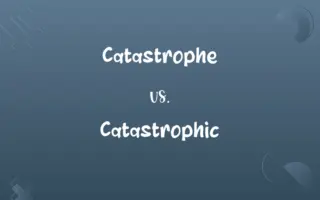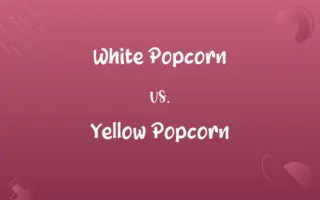Isotropic vs. Isentropic: Know the Difference

By Shumaila Saeed || Updated on December 27, 2023
Isotropic refers to properties being uniform in all directions, while isentropic denotes a process where entropy remains constant.

Key Differences
Isotropic properties are those that are identical in all directions, implying uniformity and consistency in physical characteristics. Isentropic processes, in contrast, are thermodynamic processes that occur without any change in entropy, representing a reversible and adiabatic change.
Shumaila Saeed
Dec 27, 2023
In the field of physics and materials science, isotropy is a crucial consideration in assessing materials that exhibit uniform properties irrespective of orientation. Isentropic processes are vital in thermodynamics and fluid dynamics, where they describe idealized, efficient processes in systems like engines and turbines.
Shumaila Saeed
Dec 27, 2023
The isotropy of a material can be measured through various physical tests to confirm uniformity in different directions. Isentropic efficiency is a measure in thermodynamics that assesses how closely a real-world process approximates an ideal isentropic process.
Shumaila Saeed
Dec 27, 2023
Isotropic materials are preferred in manufacturing and construction for their predictable behavior under stress and temperature changes. Isentropic assumptions are used in the design of thermodynamic systems to optimize performance under ideal conditions.
Shumaila Saeed
Dec 27, 2023
Isotropy implies that a material's properties, like strength and conductivity, do not vary with direction. Isentropic processes imply idealized conditions where energy transfer is most efficient, often used as benchmarks in engineering studies.
Shumaila Saeed
Dec 27, 2023
ADVERTISEMENT
Comparison Chart
Definition
Uniform properties in all directions
Process with constant entropy
Shumaila Saeed
Dec 27, 2023
Primary Field of Use
Physics, materials science
Thermodynamics, fluid dynamics
Shumaila Saeed
Dec 27, 2023
Key Characteristics
Directional uniformity
Entropy constancy and reversibility
Shumaila Saeed
Dec 27, 2023
Measurement
Physical tests for uniform properties
Efficiency compared to ideal process
Shumaila Saeed
Dec 27, 2023
Application in Design
Material selection and construction
Thermodynamic system optimization
Shumaila Saeed
Dec 27, 2023
ADVERTISEMENT
Isotropic and Isentropic Definitions
Isotropic
Material properties are consistent in every direction.
Glass is often considered isotropic for its uniform optical properties.
Shumaila Saeed
Dec 27, 2023
Isentropic
A theoretical step in thermodynamic cycles without entropy change.
The isentropic process in a Carnot cycle represents the ideal limit of efficiency.
Shumaila Saeed
Dec 27, 2023
Isotropic
The material behaves the same way regardless of orientation.
Isotropic metals are preferred in manufacturing for their predictable strength.
Shumaila Saeed
Dec 27, 2023
Isentropic
Used as a standard for comparing real processes in engineering.
Turbine performance is often measured against an isentropic model.
Shumaila Saeed
Dec 27, 2023
Isotropic
Material consistency that does not vary with direction.
Isotropic foam is used in cushions for its uniform comfort regardless of how it's positioned.
Shumaila Saeed
Dec 27, 2023
ADVERTISEMENT
Isentropic
Indicates the ideal efficiency of thermodynamic systems.
Isentropic efficiency is a key metric in assessing the performance of refrigeration cycles.
Shumaila Saeed
Dec 27, 2023
Isotropic
The characteristics of the material do not change with direction.
Engineers use isotropic materials for components that face stress from multiple directions.
Shumaila Saeed
Dec 27, 2023
Isentropic
A thermodynamic process that maintains entropy at a constant level.
Isentropic compression is an ideal model for engine efficiency studies.
Shumaila Saeed
Dec 27, 2023
Isotropic
A structure that exhibits symmetry in all directions.
The isotropic nature of some crystals simplifies their study in physics.
Shumaila Saeed
Dec 27, 2023
Isentropic
A process where there's no heat transfer and entropy remains constant.
In an isentropic expansion of a gas, no heat is exchanged with the surroundings.
Shumaila Saeed
Dec 27, 2023
Isotropic
Identical in all directions; invariant with respect to direction.
Shumaila Saeed
Oct 19, 2023
Isotropic
(physics) Having properties that are identical in all directions; exhibiting isotropy
Shumaila Saeed
Oct 19, 2023
Isotropic
(maths) Having the same components in all rotated coordinate systems
Shumaila Saeed
Oct 19, 2023
Isotropic
Having the same properties in all directions; specifically, equally elastic in all directions.
Shumaila Saeed
Oct 19, 2023
Repeatedly Asked Queries
What does isotropic mean?
Isotropic means having uniform properties in all directions.
Shumaila Saeed
Dec 27, 2023
How is isotropy tested?
Isotropy is tested through physical experiments to measure properties in different directions.
Shumaila Saeed
Dec 27, 2023
Can a real-world process be perfectly isentropic?
No, real-world processes often deviate from ideal isentropic conditions.
Shumaila Saeed
Dec 27, 2023
Why are isotropic materials important?
They are important for applications where uniform performance regardless of orientation is needed.
Shumaila Saeed
Dec 27, 2023
Are all materials isotropic?
No, many materials are anisotropic, having different properties in different directions.
Shumaila Saeed
Dec 27, 2023
Can isotropy vary with temperature?
Yes, the isotropic nature of materials can change with temperature.
Shumaila Saeed
Dec 27, 2023
What is an isentropic process?
An isentropic process is a thermodynamic change where entropy remains constant.
Shumaila Saeed
Dec 27, 2023
What is isentropic efficiency?
Isentropic efficiency is the measure of how closely a real process approaches an ideal isentropic process.
Shumaila Saeed
Dec 27, 2023
Are isotropic properties only relevant to solids?
No, isotropy can apply to liquids and gases as well.
Shumaila Saeed
Dec 27, 2023
Are isentropic processes reversible?
Yes, by definition, they are reversible as there is no entropy change.
Shumaila Saeed
Dec 27, 2023
What are common examples of isentropic processes?
Ideal gas compression and expansion in thermodynamic cycles are examples.
Shumaila Saeed
Dec 27, 2023
Is isentropic ideal for all thermodynamic systems?
Isentropic is an ideal model, often unachievable but useful for theoretical understanding and design.
Shumaila Saeed
Dec 27, 2023
Is glass isotropic?
Generally, glass is considered isotropic, but it can have anisotropies due to manufacturing processes.
Shumaila Saeed
Dec 27, 2023
Are all reversible processes isentropic?
Not all reversible processes are isentropic; isentropic specifically refers to constant entropy.
Shumaila Saeed
Dec 27, 2023
How does isentropic assumption aid engineers?
It provides a benchmark for efficiency and helps in designing more efficient systems.
Shumaila Saeed
Dec 27, 2023
Do isotropic materials have the same strength in all directions?
Yes, isotropic materials typically have uniform strength in all directions.
Shumaila Saeed
Dec 27, 2023
Can light propagation be isotropic?
Yes, in isotropic media, light propagates uniformly in all directions.
Shumaila Saeed
Dec 27, 2023
What is an example of an isotropic medium?
A homogeneous and uniform glass block is an example of an isotropic medium.
Shumaila Saeed
Dec 27, 2023
How is isentropic flow important in aerodynamics?
Isentropic flow models help in designing efficient and effective aerospace components.
Shumaila Saeed
Dec 27, 2023
What factors affect isentropic efficiency?
Factors include system design, operating conditions, and material properties.
Shumaila Saeed
Dec 27, 2023
Share this page
Link for your blog / website
HTML
Link to share via messenger
About Author
Written by
Shumaila SaeedShumaila Saeed, an expert content creator with 6 years of experience, specializes in distilling complex topics into easily digestible comparisons, shining a light on the nuances that both inform and educate readers with clarity and accuracy.




































































